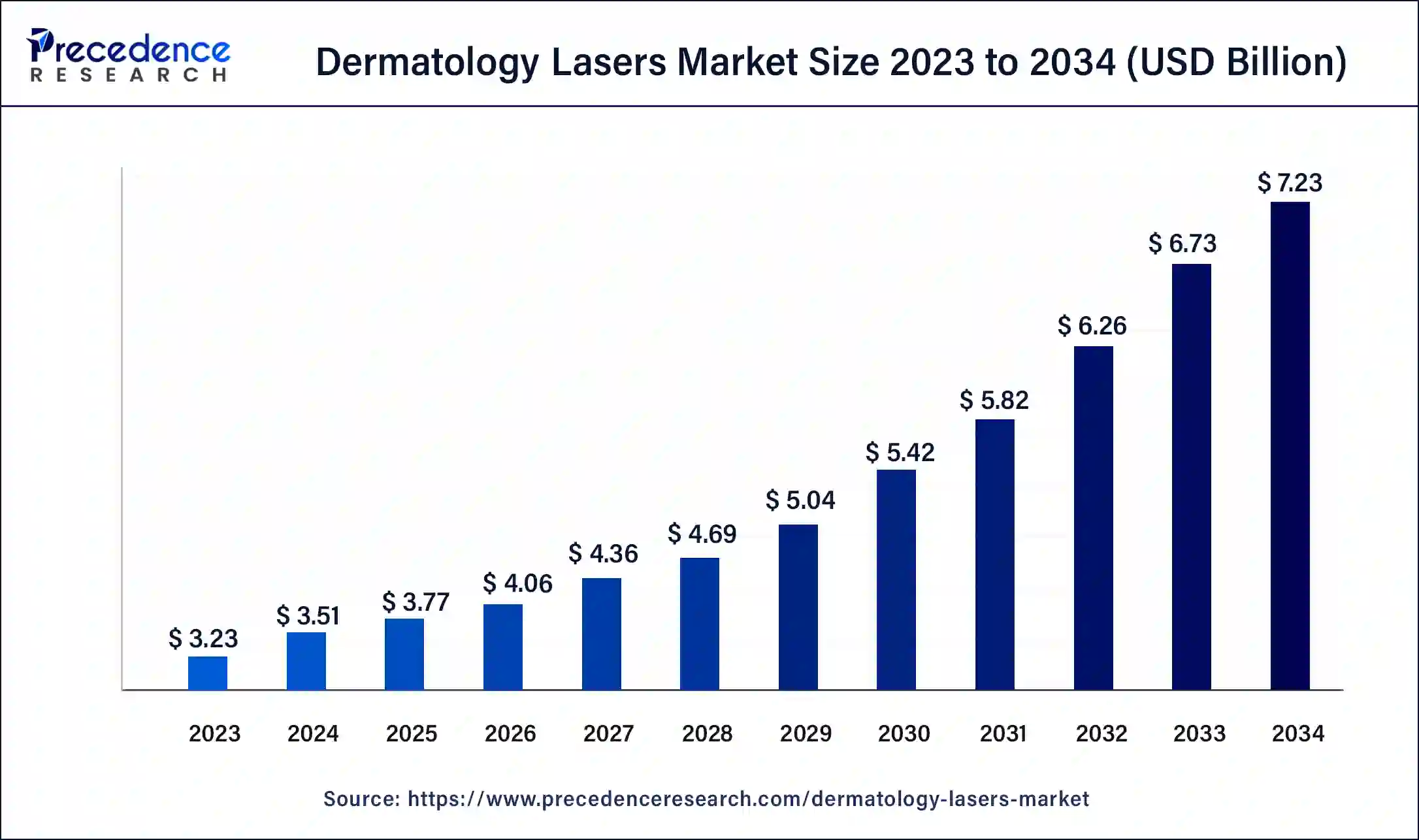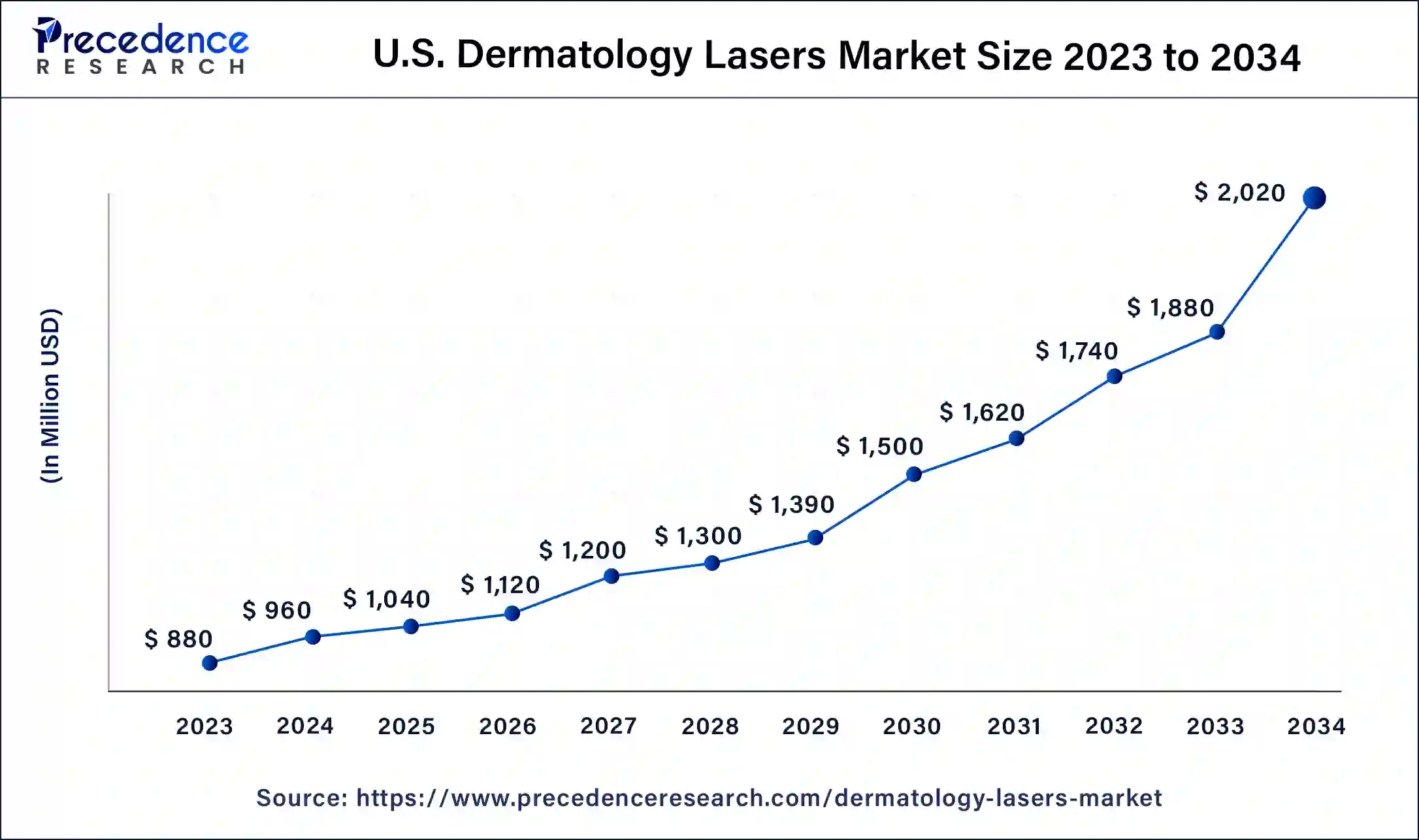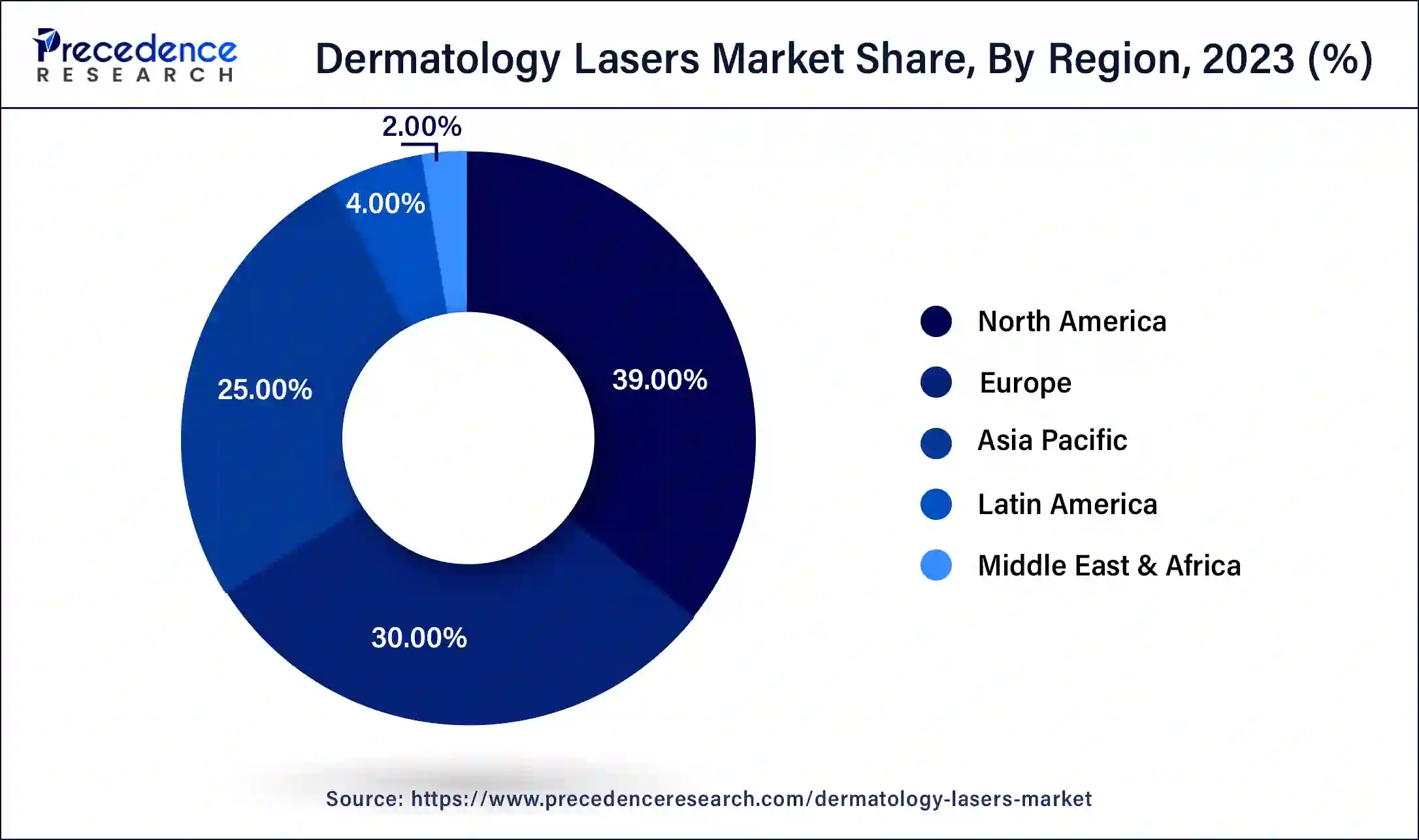November 2024
The global dermatology lasers market size was USD 3.23 billion in 2023, calculated at USD 3.51 billion in 2024 and is projected to surpass around USD 7.23 billion by 2034, expanding at a CAGR of 7.5% from 2024 to 2034.
The global dermatology lasers market size accounted for USD 3.51 billion in 2024 and is expected to be worth around USD 7.23 billion by 2034, at a CAGR of 7.5% from 2024 to 2034. The North America dermatology lasers market size reached USD 1.26 billion in 2023. The medical equipment used to treat a variety of disorders connected to the skin is called a dermatology laser. dermatology lasers are used to treat illnesses, issues related to aesthetic issues, and skin conditions.

The U.S. dermatology lasers market size was estimated at USD 880 million in 2023 and is predicted to be worth around USD 2,020 million by 2034, at a CAGR of 7.7% from 2024 to 2034.

North America is anticipated to lead the dermatology laser products market, accounting for more than 39% of the global value, thanks to rising awareness of skin disorders and a high standard of living. The richness of the area is a result of people's knowledge of skin conditions and willingness to pay for medical care. Due to the country's growing reliance on social media over the past ten years, the aesthetics industry in the United States has experienced tremendous growth. The growing desire for the ideal physique and life among celebrities and social influencers has shaped aesthetic trends and the laser treatment business in the US. The availability of a wide range of dermatology and cosmetic laser treatments, the population's rising purchasing power, the popularity of cosmetic surgery, and the presence of significant dermatology laser machine suppliers are some of the key factors predicted to influence the dermatology laser market. The prevalence of skin cancer is also expected to have an impact on the use of laser therapy, leading to higher dermatology laser sales.

Europe is anticipated to continue to be the second-most lucrative market over the evaluation period despite its low value. Demand for dermatology lasers in the area is fueled by the social and economic effects of skin conditions as well as the support provided by the regional governments to lower the occurrence. The need for dermatology laser products grows along with the prevalence of psoriasis. The rising need for less invasive operations will similarly continue to be a major development driver in Europe. Throughout the anticipated period, East Asia would continue to be a crucial area, with a significant market share increase anticipated. The improvement in living conditions and the growth of the healthcare system in the area, both of which are paving the way for hair removal and face rejuvenation operations, are related to the market's expansion.
Scar removal, hair removal, skin imperfection reduction, psoriasis therapy, wound treatments, and facial wrinkle reduction are just a few of the skin-related operations that are treated with lasers. Due to their effectiveness and focused approach, lasers have become powerful medicinal equipment in the dermatology laser devices business. The growth of the dermatology lasers market is anticipated to be aided by the development of a variety of cutting-edge laser technologies for treating numerous skin diseases, including fractional radiofrequency devices, pulsed dye lasers, alexandrite lasers, CO2 fractional lasers, solid-state lasers, intense pulsed light, and other lasers. Consumers are increasingly seeking treatments to get rid of lines and wrinkles, tighten sagging skin, and remove dark spots as a result of increased worries about their appearance and improving living standards.
Similarly to this, the market will continue to grow during the forecast period due to the growing incidence of skin issues and greater awareness of the availability of cutting-edge laser-based therapies. The projection period is expected to see a significant increase in demand for dermatology lasers. An important element driving the growth of the worldwide dermatology lasers market is people's increasing preoccupation with appearance and cosmetology. The prevalence of skin cancer is increasing. The World Health Organization predicts that between 2 and 3 million non-melanoma skin cancers and between 130,000 and 140,000 melanoma skin cancers will be diagnosed annually worldwide, which is also fueling the expansion of the global dermatology lasers market over the next years. Another significant reason driving the growth of the worldwide dermatology lasers markets is the rise in the elderly population and the baby boomers since many of them undergo laser surgeries. Additionally, the prevalence of unhealthy lifestyles that lead to skin diseases, environmental changes that affect the skin, the time-saving and effective results of lasers, their low side effects, and the rise in consumer demand for minimally invasive procedures and technologically advanced surgeries are all anticipated to propel the growth of the global cardiology lasers market during the forecast period.
| Report Coverage | Details |
| Market Size in 2023 | USD 3.23 Billion |
| Market Size in 2024 | USD 3.51 Billion |
| Market Size by 2034 | USD 7.23 Billion |
| Growth Rate from 2024 to 2034 | CAGR of 7.5% |
| Base Year | 2023 |
| Forecast Period | 2024 to 2034 |
| Segments Covered | Product, End User, Indication, Technology, Application, Regions |
| Regions Covered | North America, Asia Pacific, Europe, Latin America, Middle East and Africa |
Increasing medical care costs spending
The popularity of laser therapy is growing
Product recalls are impeding growth
Innovations in technology
More than half of the market's value will continue to be accounted for by solid-state lasers, which remain the most common. The popularity of solid-state lasers is due to their ability to generate near-infrared wavelengths that easily absorb by the chromospheres of melanin and hemoglobin and penetrate deep into the skin.
Solid-state lasers are ideal for complex treatments because they can easily penetrate deep skin tissues such as large blood vessels and vascular lesions. As a result, demand for solid-state lasers rises.
The dermatology and cosmetic clinics sector now accounts for more than 2/3 of market value and will retain predominance over the projected period on the strength of the increased demand among millennials to seek treatment from skin care specialists.
Currently, dermatology and cosmetic clinics are anticipated to hold a 69.6% share of the global market. Patients are increasingly choosing private clinics over hospitals since some additional charges, such as management fees, are not associated with them.
According to predictions, hospitals will have 19.2% of the worldwide market share in 2023, while ambulatory surgical centers will hold 11.2% of it.
Segment Covered in the Report
By Product
By End User
By Indication
By Technology
By Application
By Geography
For inquiries regarding discounts, bulk purchases, or customization requests, please contact us at sales@precedenceresearch.com
No cookie-cutter, only authentic analysis – take the 1st step to become a Precedence Research client
November 2024
November 2024
December 2024
November 2024